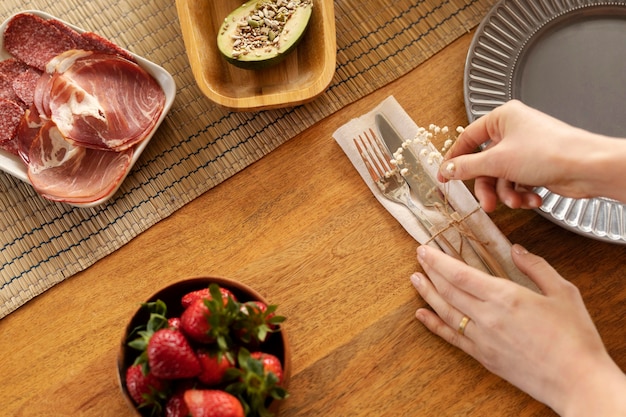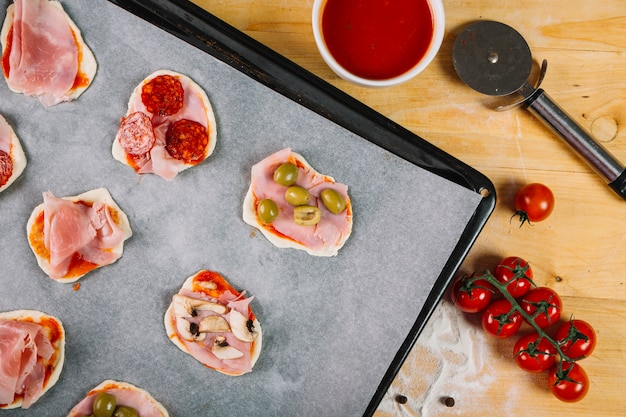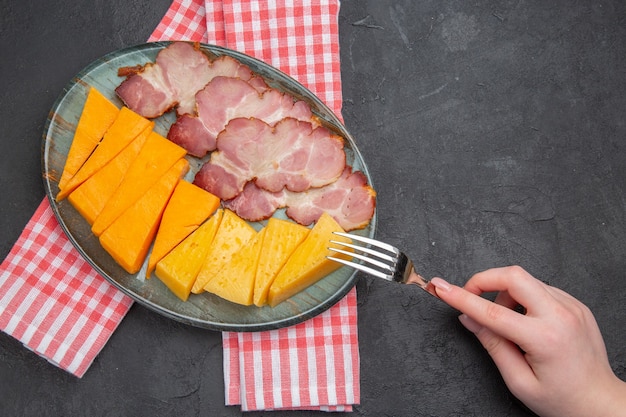(Part 1) Choosing the Right Ham: A culinary adventure Begins

types of hams: A Journey Through Flavour
Let's break down the two main categories of hams:- cured hams: Think of these as the seasoned veterans of the ham world. They've been treated with salt, sugar, and sometimes nitrates or nitrites, lending them a distinctive, salty flavour and a firmer texture. They arrive pre-cooked, making them a convenient choice for a quick meal. Just pop them in the oven for a reheating session, and voila! Deliciousness awaits. I personally adore cured hams for their simplicity and inherent flavour. Less effort, more deliciousness - that's my motto!
- fresh hams: These are the raw newcomers, uncooked and brimming with potential. They offer a more delicate flavour and a moister texture, but they require a longer cooking time. You'll need to dedicate some time to roasting or braising them, but the results are truly rewarding. It's like a culinary adventure, with every step unveiling a new layer of flavour and texture. It takes a little more effort, but trust me, the journey is worth it!
Bone-in or Boneless: The Choice is Yours
Now, consider the bone situation:- bone-in hams: These hams embrace their heritage, proudly sporting a bone that adds a richness to their flavour. They're often easier to carve, offering a satisfying experience. However, the bone slows down the cooking process, so you'll need to adjust your cooking time accordingly.
- boneless hams: For those who prefer a less hands-on approach, boneless hams offer convenience and ease of handling. The lack of bone speeds up the cooking time, making them a good choice for a busy weeknight meal.
Spiral Sliced or Whole: Unwinding the Options
Finally, the format:- spiral sliced hams: These are the ultimate convenience option, pre-sliced and ready to heat and serve. They're perfect for a quick lunch or dinner, offering a hassle-free way to enjoy delicious ham.
- whole hams: For those who enjoy a more interactive cooking experience, whole hams provide a blank canvas for culinary creativity. They offer the chance to create beautiful slices, perfect for carving at the table and adding a touch of drama to your meal. Plus, they're excellent for leftovers, providing ingredients for delicious sandwiches or salads.
(Part 2) Getting Ready to Cook: Prepping for Culinary Success

Removing the Packaging: Unveiling the Ham
The first step is to remove the packaging. If your ham is encased in plastic, it's best to take it out and rinse it under cold running water. This helps remove any lingering salt, nitrates, or packaging residue, ensuring a clean and fresh start for your cooking process.Scoring the Ham: Unleashing the Flavour
Scoring the ham is a crucial step in maximizing its flavour and texture. Using a sharp knife, make diagonal cuts across the fat layer, about 1/2 inch apart. These incisions allow the fat to render out during cooking, creating a crispy, juicy, and flavourful ham. It's like unlocking the ham's hidden potential, revealing its true culinary glory.Glazing the Ham: Adding a Touch of Magic
Now it's time to add a touch of magic – the glaze! A good glaze can transform your ham from ordinary to extraordinary, adding a burst of flavour and a beautiful, glossy finish. I'm a sucker for a classic honey mustard glaze, but the possibilities are endless! You can go for a fruity glaze, a spicy kick, or even a sweet and savory combination. And if you're feeling adventurous, you can even create your own glaze from scratch.(Part 3) Cooking Methods: Navigating the Culinary Landscape

oven roasting: The Classic Approach
This is the tried-and-true method for cooking a ham, offering simplicity and reliable results.- Preheat your oven to 325°F (160°C).
- Place the ham in a large roasting pan.
- Add a cup of water to the bottom of the pan. This creates steam, helping keep the ham moist and preventing it from drying out during the cooking process.
- Roast for approximately 15-20 minutes per pound. For a 10-pound ham, that's about 3.5 hours. The key is to cook the ham until the internal temperature reaches 140°F (60°C). This ensures that the ham is cooked through and safe to eat.
slow cooking: The Hands-Off Approach
For those who prefer a more relaxed approach, slow cooking is a fantastic option.- Place the ham in your slow cooker.
- Add a cup of water or broth to the bottom of the cooker, providing moisture for tender results.
- Cook on low for 6-8 hours, or on high for 3-4 hours. Again, you'll want to check the internal temperature to make sure it reaches 140°F (60°C).
Boiling: A Traditional Technique
Boiling a ham is a traditional method, especially popular in certain regions. It's a simple and effective way to achieve tender, moist ham.- Place the ham in a large pot or dutch oven.
- Cover the ham with water, adding a bay leaf and a few peppercorns for a hint of added flavour.
- Bring the water to a boil, then reduce the heat to a simmer and cook for about 20-25 minutes per pound.
Grilling: Adding a Smoky Touch
For those who enjoy a smoky flavour, grilling is a great option.- Preheat your grill to medium heat.
- Place the ham on the grill, ensuring even cooking by rotating it occasionally.
- Cook for about 15-20 minutes per side, or until the internal temperature reaches 140°F (60°C).
(Part 4) Internal Temperature and Doneness: Ensuring Culinary Perfection
The most important thing when cooking a ham is to ensure that it's cooked through and safe to eat. This means checking the internal temperature.- safe internal temperature: The internal temperature of a cooked ham should reach 140°F (60°C). This is the magic number that ensures any harmful bacteria are eliminated, making your ham safe and delicious.
- Other Signs of Doneness: While the internal temperature is the most reliable indicator, you can also look for other signs of doneness. The ham should be cooked through and no longer pink in the middle. The fat should be rendered and slightly crispy, and the ham should be tender and juicy.
(Part 5) Resting the Ham: Letting the Flavours Settle
After your ham reaches the target temperature, resist the urge to carve it immediately. Instead, allow it to rest for about 15-20 minutes. This allows the juices to redistribute throughout the ham, ensuring a moister and more flavorful final product.- Resting Time: Give your ham a little TLC and let it relax for those crucial 15-20 minutes.
- Covering the Ham: While the ham rests, cover it with aluminium foil to keep it warm and prevent it from drying out.
(Part 6) Carving and Serving: Unveiling the Culinary Masterpiece
The moment has arrived! Your ham is cooked to perfection, and now it's time to carve it and serve it up. This is the culmination of your culinary efforts, and it should be celebrated!Carving Techniques: Mastering the Art of Slicing
Carving a ham might seem intimidating, but it's actually quite simple with a few key techniques.- Use a Sharp Knife: A sharp, sturdy knife is essential for making clean, even slices. A carving knife is ideal, but a chef's knife will do the trick.
- Follow the Grain: To achieve tender slices, cut against the grain of the meat. This will make the ham easier to chew and enhance the overall eating experience.
- Bone-in Hams: For bone-in hams, you'll need to carefully separate the meat from the bone. Use your knife to gently cut the meat away from the bone, then slice the meat as you would with a boneless ham.
Serving Suggestions: Creating a Culinary Symphony
You've got those gorgeous ham slices ready, but how to serve them?- Classic Sides: Pair your ham with classic sides like mashed potatoes, green beans, sweet potatoes, or cornbread for a comforting and familiar taste.
- Creative Sides: Get adventurous with your sides! Roasted vegetables, fresh salads, or even fruit can complement the ham in unexpected ways.
- Sandwiches and Salads: leftover ham is fantastic for sandwiches and salads. Transform your leftovers into a delicious ham and cheese sandwich or a hearty ham salad.
(Part 7) Storage and Leftovers: Extending the Culinary Delight
You've created a feast, and now you have those wonderful leftovers. Don't let them go to waste! With proper storage and a bit of culinary creativity, you can enjoy delicious ham for days to come.Storing Leftovers: Preserving the Magic
First, you need to ensure your leftovers are stored correctly.- Refrigerate: Place the leftover ham in an airtight container and refrigerate it within 2 hours of cooking. This helps prevent bacterial growth and ensures the quality of your ham.
- Freezing: Leftover ham can be frozen for future use. Wrap it tightly in plastic wrap and aluminium foil, or place it in a freezer-safe bag. Frozen ham can last for 2-3 months.
Using Leftovers: Transforming the Culinary Treasure
Now for the exciting part: what to do with those delicious leftovers?- ham and cheese sandwiches: Leftover ham is a perfect base for a classic sandwich. Pair it with cheddar cheese, mustard, and a crusty roll for a simple yet satisfying meal.
- Ham Salad: Chop up your leftover ham, add mayonnaise, celery, onion, and spices for a hearty and flavourful ham salad. It's a perfect filling for sandwiches or a topping for crackers.
- Soups and Stews: Ham bones are a culinary treasure, adding depth of flavour to soups and stews. Use them to create rich stocks, which can be the foundation for a variety of warm and comforting dishes.
- pasta dishes: Leftover ham can be incorporated into pasta dishes, providing protein and a savory flavour.
(Part 8) Tips and Tricks: Enhancing Your culinary journey
Over the years, I've picked up some valuable tips and tricks that can help you achieve ham-cooking perfection.- Don't Overcook: Overcooking a ham can result in dry and tough meat. Aim for the target internal temperature, but don't exceed it.
- Glaze Early: Adding the glaze early in the cooking process allows it to caramelize and create a beautiful, sticky finish.
- Use a Thermometer: Always use a meat thermometer to ensure your ham is cooked through. This is the key to achieving culinary success and a safe meal.
- Rest the Ham: Allowing the ham to rest after cooking allows the juices to redistribute, resulting in a more juicy and flavorful ham.
(Part 9) FAQs: Addressing Common Ham-Cooking Concerns
Let's address some of the common questions about cooking a 10-pound ham:| Question | Answer |
|---|---|
| How long does it take to cook a 10-pound ham in the oven? | A 10-pound ham should cook in the oven for about 3 hours and 30 minutes at 325°F (160°C). It's best to check the internal temperature to ensure it reaches 140°F (60°C). |
| How do I know when a ham is done? | You can tell if a ham is done by checking the internal temperature using a meat thermometer. The safe internal temperature for ham is 140°F (60°C). You can also look for other signs of doneness, such as the ham being cooked through and no longer pink in the middle, and the fat being rendered and a bit crispy. |
| Can I cook a ham in the slow cooker? | Yes, you can cook a ham in a slow cooker. Place the ham in the slow cooker, add a cup of water or broth, and cook on low for 6-8 hours or on high for 3-4 hours, or until the internal temperature reaches 140°F (60°C). |
| What happens if I overcook a ham? | Overcooking a ham can make it dry and tough. If you're worried about overcooking, you can always take the ham out of the oven a few degrees shy of the target temperature and allow it to rest for a few minutes to finish cooking. |
| Can I freeze leftover ham? | Yes, you can freeze leftover ham. Wrap it tightly in plastic wrap and aluminium foil, or place it in a freezer-safe bag. Frozen ham can last for 2-3 months. |
Everyone is watching

How to Cook Frozen Lobster Tails Perfectly: A Step-by-Step Guide
RecipesLobster. Just the word conjures up images of lavish meals, special occasions, and a taste of luxury. But let's...

Pigs in a Blanket Cooking Time: How Long to Bake for Perfect Results
RecipesAh, pigs in a blanket. Just the name conjures up images of those delightful little parcels of crispy pastry en...

Pork Fillet Cooking Time: How Long to Cook It Perfectly
RecipesPork fillet, or tenderloin as it's sometimes called, is a real favourite in our house. It's so versatile, and...

The Ultimate Guide to Cooking Delicious Frankfurters
RecipesLet's face it, we all love a good frankfurter. It's a classic, simple, and always satisfying. But let's be rea...

The Ultimate Guide to Tender, Juicy Pulled Pork
RecipesRight, let's talk pulled pork. It's one of those dishes that just screams "comfort food," doesn't it? I mean...
